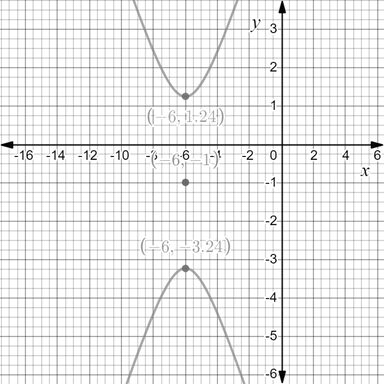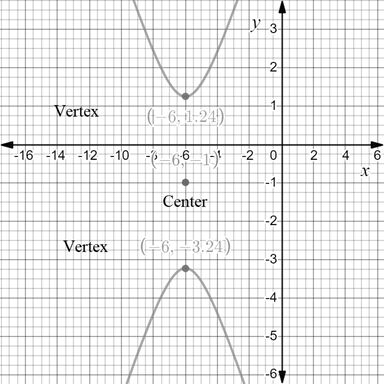
(a)
To find: The standard equation of hyperbola
(a)
Answer to Problem 38E
The standard form of the hyperbola is.
Explanation of Solution
Given information:
The equation of the hyperbola is
Calculation:
Write the equation of the hyperbola.
Simplify further.
Therefore, the standard form of the hyperbola is.
(b)
To find: The center, vertices, foci, asymptotes of hyperbola
(b)
Answer to Problem 38E
The center of the hyperbola is
Explanation of Solution
Given information:
Given equation of hyperbola is
Calculation:
Write the equation of the hyperbola.
Simplify further to find the standard equation of the hyperbola
Compare the given equation with the standard equation of hyperbola.
The center of the hyperbola is given as
The vertices of the hyperbola is given by
So the vertices are
The foci of the hyperbola is given by
Calculate the value of
Hence the foci are.
The asymptotes of the hyperbola is given by.
Substitute
.
Therefore The center of the hyperbola is
(c)
To draw: The graph of the hyperbola
(c)
Answer to Problem 38E
The graph of the hyperbola is shown in figure (1).
Explanation of Solution
Given information:
The equation of the hyperbola is
Calculation:
To draw the graph of hyperbola, solve the equations of hyperbola in terms of
Simplify further.
Use the above equation and the asymptotes to draw the graph of the hyperbola.

Figure
Therefore, the graph of the hyperbola is shown in figure (1).
Verify the result using the graphical utility:
Draw the graph of the hyperbola using the graphical utility.

From the above, it is clear that both the graphs are similar.
Hence, proved.
Chapter 9 Solutions
Precalculus with Limits: A Graphing Approach
- Find the length of the following curve. 3 1 2 N x= 3 -y from y 6 to y=9arrow_forward3 4/3 3213 + 8 for 1 ≤x≤8. Find the length of the curve y=xarrow_forwardGiven that the outward flux of a vector field through the sphere of radius r centered at the origin is 5(1 cos(2r)) sin(r), and D is the value of the divergence of the vector field at the origin, the value of sin (2D) is -0.998 0.616 0.963 0.486 0.835 -0.070 -0.668 -0.129arrow_forward
- 10 The hypotenuse of a right triangle has one end at the origin and one end on the curve y = Express the area of the triangle as a function of x. A(x) =arrow_forwardIn Problems 17-26, solve the initial value problem. 17. dy = (1+ y²) tan x, y(0) = √√3arrow_forwardcould you explain this as well as disproving each wrong optionarrow_forward
- could you please show the computation of this by wiresarrow_forward4 Consider f(x) periodic function with period 2, coinciding with (x) = -x on the interval [,0) and being the null function on the interval [0,7). The Fourier series of f: (A) does not converge in quadratic norm to f(x) on [−π,π] (B) is pointwise convergent to f(x) for every x = R П (C) is in the form - 4 ∞ +Σ ak cos(kx) + bk sin(kx), ak ‡0, bk ‡0 k=1 (D) is in the form ak cos(kx) + bk sin(kx), ak 0, bk 0 k=1arrow_forwardSolve the equation.arrow_forward
 Calculus: Early TranscendentalsCalculusISBN:9781285741550Author:James StewartPublisher:Cengage Learning
Calculus: Early TranscendentalsCalculusISBN:9781285741550Author:James StewartPublisher:Cengage Learning Thomas' Calculus (14th Edition)CalculusISBN:9780134438986Author:Joel R. Hass, Christopher E. Heil, Maurice D. WeirPublisher:PEARSON
Thomas' Calculus (14th Edition)CalculusISBN:9780134438986Author:Joel R. Hass, Christopher E. Heil, Maurice D. WeirPublisher:PEARSON Calculus: Early Transcendentals (3rd Edition)CalculusISBN:9780134763644Author:William L. Briggs, Lyle Cochran, Bernard Gillett, Eric SchulzPublisher:PEARSON
Calculus: Early Transcendentals (3rd Edition)CalculusISBN:9780134763644Author:William L. Briggs, Lyle Cochran, Bernard Gillett, Eric SchulzPublisher:PEARSON Calculus: Early TranscendentalsCalculusISBN:9781319050740Author:Jon Rogawski, Colin Adams, Robert FranzosaPublisher:W. H. Freeman
Calculus: Early TranscendentalsCalculusISBN:9781319050740Author:Jon Rogawski, Colin Adams, Robert FranzosaPublisher:W. H. Freeman
 Calculus: Early Transcendental FunctionsCalculusISBN:9781337552516Author:Ron Larson, Bruce H. EdwardsPublisher:Cengage Learning
Calculus: Early Transcendental FunctionsCalculusISBN:9781337552516Author:Ron Larson, Bruce H. EdwardsPublisher:Cengage Learning





